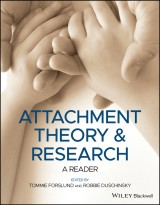Details

Attachment Theory and Research
A Reader1. Aufl.
|
44,99 € |
|
| Verlag: | Wiley-Blackwell |
| Format: | |
| Veröffentl.: | 26.02.2021 |
| ISBN/EAN: | 9781119657897 |
| Sprache: | englisch |
| Anzahl Seiten: | 288 |
DRM-geschütztes eBook, Sie benötigen z.B. Adobe Digital Editions und eine Adobe ID zum Lesen.
Beschreibungen
<p>As interest in attachment theory continues to grow, misconceptions of the theory are becoming increasingly common. Important texts on major theoretical and empirical contributions are often too extensive for non-specialist readers or not readily available to clinicians. Designed to address a significant gap in literature, <i>Attachment Theory and Research</i>: <i>A Reader</i>presents a carefully curated selection of book chapters and journal articles on the subject—complemented by previously unpublished material by the founder of the theory. This valuable new resource provides practitioners, students, policymakers, and general readers an accessible and up-to-date view of the concepts, development, and diversity of attachment theory.</p> <p>The <i>Reader</i> comprises 15 succinct chapters by many of the most influential researchers in the theory, covering the basis of attachment theory and the current state of the field. The book brings together a wide range of works, many of which challenge common assumptions and offer intriguing new insights on attachment theory and research. Topics include psychoanalytic theories of separation anxiety, concepts of anxiety, stress, and homeostasis, the origins of disorganized attachment, cultural differences in caregiving practices, reactive attachment disorder (RAD) and disinhibited social engagement disorder (DSED), the future prospects of attachment theory, and more.</p>
<p>Introduction 1<br /><i>Tommie Forslund and Robbie Duschinsky</i></p> <p>1 Separation Anxiety 11<br /><i>John Bowlby</i></p> <p>2 Anxiety, Stress, and Homeostasis 34<br /><i>John Bowlby</i></p> <p>3 Attachment 46<br /><i>Mary D. Salter Ainsworth</i></p> <p>4 Love as Attachment: The Integration of Three Behavioral Systems 74<br /><i>Phillip R. Shaver, Cindy Hazan, and Donna Bradshaw</i></p> <p>5 Relationships, Self, and Individual Adaptation 91<br /><i>L. Alan Sroufe</i></p> <p>6 Disorganized/Disoriented Infant Behavior in the Strange Situation, Lapses in the Monitoring of Reasoning and Discourse during the Parent’s Adult Attachment Interview, and Dissociative States 108<br /><i>M. Main and E. Hesse</i></p> <p>7 The Prototype Hypothesis and the Origins of Attachment Working Models: Adult Relationships with Parents and Romantic Partners 132<br /><i>Gretchen Owens, Judith A. Crowell, Helen Pan, Dominique Treboux, Elizabeth O’Connor, and Everett Waters</i></p> <p>8 Dynamics of Romantic Love: Comments, Questions, and Future Directions 144<br /><i>Phillip R. Shaver</i></p> <p>9 Integrating Temperament and Attachment: The Differential Susceptibility Paradigm 164<br /><i>Marinus H. van IJzendoorn and Marian J. Bakermans-Kranenburg</i></p> <p>10 Annual Research Review: Attachment Disorders in Early Childhood: Clinical Presentation, Causes, Correlates, and Treatment 184<br /><i>Charles H. Zeanah and Mary Margaret Gleason</i></p> <p>11 Attachment Disorders Versus More Common Problems in Looked After and Adopted Children: Comparing Community and Expert Assessments 202<br /><i>Matt Woolgar and Emma Baldock</i></p> <p>12 Attachment in the Early Life Course: Meta-Analytic Evidence for Its Role in Socioemotional Development 211<br /><i>Ashley M. Groh, R. M. Pasco Fearon, Marinus H. van IJzendoorn, Marian J. Bakermans-Kranenburg, </i><i>and Glenn I. Roisman</i></p> <p>13 Attachment and Biobehavioral Catch-up: Addressing the Needs of Infants and Toddlers Exposed to Inadequate or Problematic Caregiving 220<br /><i>Mary Dozier and Kristin Bernard</i></p> <p>14 Children’s Multiple Attachment Relationships and Representations in Different Family Contexts 228<br /><i>Fabien Bacro, Tommie Forslund, and Pehr Granqvist</i></p> <p>15 New Correlates of Disorganization from a West-African Dataset, and Shared Rhythmic Touch as a Hidden Pathway to Infant Attachment Security 240<br /><i>Mary McMahan True</i></p> <p>Index 259</p>
<p><b>TOMMIE FORSLUND,</b> Psychologist, PhD, is a researcher at the Department of Psychology, Stockholm University; and a researcher at SUF Resource Center, Region Uppsala, Sweden. He is a coder of the Strange Situation Procedure, author of an international consensus statement regarding attachment theory and research, and winner of The Society in Emotion and Attachment Studies dissertation award “Excellence in Attachment Research”.</p> <p><b>ROBBIE DUSCHINSKY,</b> PhD, is University Senior Lecturer in Social Sciences in the Primary Care Unit, University of Cambridge; and Director of Studies and a Fellow at Sidney Sussex College. He is the author of <i>Cornerstones of Attachment Research</i> (2020) and, with Kate White, co-editor of <i>Trauma and Loss: Key Texts from the John Bowlby Archive</i> (2019).
<p><b>ATTACHMENT THEORY & RESEARCH</b> A READER</p> <p>Interest in attachment theory and research continues to grow among practitioners, students, policymakers, and general readers. Yet many important texts are hard to obtain, making it difficult for audiences to understand both some of the central aspects and the diversity of this area of inquiry. Some texts are no longer in print, others were not published in English, others are difficult to find. <i>Attachment Theory and Research: A Reader</i> presents a carefully curated selection of book chapters and journal articles on the subject—complemented by previously unpublished material by the founder of the theory, John Bowlby. This valuable new resource provides an accessible and up-to-date view of the concepts, empirical findings, and different perspectives of scholars of attachment. <p>The book offers both a good starting point for relative newcomers, and much that will interest more specialist readers. Topics include the nature of attachment, the relationship between attachment and temperament, the psychological processes underpinning disorganized attachment, difficulties in the diagnosis of attachment disorders, the role of attachment in shaping social and personality development, cultural differences in caregiving practices, possibilities for attachment-based support for families, the future prospects for attachment research, and more.
Diese Produkte könnten Sie auch interessieren:

Cognitive-Behavioural Therapy for ADHD in Adolescents and Adults

von: Susan Young, Jessica Bramham

41,99 €

Cognitive-Behavioural Therapy for ADHD in Adolescents and Adults

von: Susan Young, Jessica Bramham

41,99 €

Offenders with Developmental Disabilities

von: William R. Lindsay, John L. Taylor, Peter Sturmey

53,99 €













